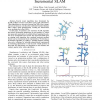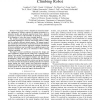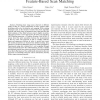125
click to vote
RSS
2007
15 years 2 months ago
2007
Abstract— This paper proposes a simulation-based active policy learning algorithm for finite-horizon, partially-observed sequential decision processes. The algorithm is tested i...
107
Voted
RSS
2007
2007
Simultaneous Localisation and Mapping in Dynamic Environments (SLAMIDE) with Reversible Data Associa
15 years 2 months ago
Abstract— The conventional technique for dealing with dynamic objects in SLAM is to detect them and then either treat them as outliers [20][1] or track them separately using trad...
98
Voted
RSS
2007
15 years 2 months ago
2007
— Several recent algorithms have formulated the SLAM problem in terms of non-linear pose graph optimization. These algorithms are attractive because they offer lower computationa...
RSS
2007
15 years 2 months ago
2007
Abstract— This paper reviews a template for dynamical climbing originating in biology, explores its stability properties in a numerical model, and presents empirical data from a ...
125
Voted
RSS
2007
15 years 2 months ago
2007
— Matching laser range scans observed at different points in time is a crucial component of many robotics tasks, including mobile robot localization and mapping. While existing t...
95
Voted
RSS
2007
15 years 2 months ago
2007
— A simple approach for mobile robots to exploit multipath fading in order to improve received radio signal strength (RSS), is presented. The strategy is to sample the RSS at dis...
118
Voted
RSS
2007
15 years 2 months ago
2007
— This paper considers the problem of controlling a group of agents under the constraint that every agent must be given the same control input. This problem is relevant for the c...
108
Voted
RSS
2007
15 years 2 months ago
2007
— Multi-robot systems require efficient and accurate planning in order to perform mission-critical tasks. However, algorithms that find the optimal solution are usually computa...
90
Voted
RSS
2007
15 years 2 months ago
2007
— In this paper, we design planar nR serial chains that provide one degree-of-freedom movement for an end-effector through five arbitrarily specified task positions. These chai...
104
Voted
RSS
2007
15 years 2 months ago
2007
—In this paper we show that all processes associated to the move-sense-update cycle of EKF SLAM can be carried out in time linear in the number of map features. We describe Divid...



